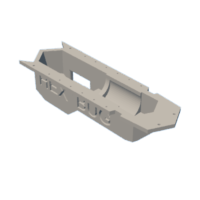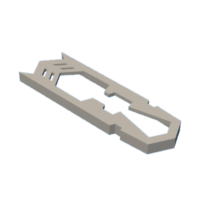Introduction: Huge 3D Printed Working Hexbug Nano
I love tiny things, so I decided to challenge myself and create a giant working Hexbug Nano! In case you don’t know what a Hexbug Nano is, it is a tiny toy that uses a motor and counterweight to vibrate, creating bug-like movement.
Supplies
For this project you will need:
- 1 - 1” DC motor (I used one from a broken cardboard cutting tool. If you use a different size motor, modify the design accordingly.)
- 1 - 9-volt battery and battery clip connector (available at your local hardware store)
- 1 - Rocker switch (available at your local hardware store)
- 1 - Butt splice (available at your local hardware store)
- 12 - Silicone twist ties, I got the 24 pack to have more color choice and in case some broke, which they did (order them off Amazon here https://www.amazon.com/Nite-Ize-GTPP3-A2-R8-Original-Reusable/dp/B00SHBMT1C/ref=sr_1_6?crid=2XWH9WGIRUC7M&keywords=3-inch%2Bsilicone%2BGear%2BTie&qid=1683214665&sprefix=3-inch%2Bsilicone%2Bgear%2Btie%2Caps%2C121&sr=8-6&th=1
- 4 - 3/8” #2 screws (available at your local hardware store)
- Electrical tape (available at your local hardware store)
- 1 - Large nut - approx 1/2” (available at your local hardware store)
- Double-sided tape or adhesive foam (available at your local hardware store)
Step 1: 3D Print the Body
Below are the stl files from the fusion 360 CAD model. This was my first big project using fusion 360, I learned as I went and really enjoyed it. The only problem with the Cad model is that the screw holes are visible from the inside and the leg holes need to be drilled out slightly.
Step 2: Connect and Add the Wiring
To create the movement in the Hexbug, we need to wire a simple circuit.
First, connect the positive wire from the motor to the positive wire on the battery with a splice. Next pull the wires through the opening for the switch. Then connect the negative ends of the motor wire and battery to the switch. Tip: if your motor wires are short, make sure the negative motor wire is connected to the switch on the closest side. Secure with electrical tape. Finally, pull the wires connected to the switch back through and push the switch in until it clicks into place. Add the battery pack, test the connections, and the wiring is done!
Step 3: Add the Motor Weight and Secure the Motor
To make the Hexbug move, we need to unbalance the motor shaft. To do this, glue the motor shaft to one spot on the inside of the nut so it’s off balance. If you have a smaller nut, glue the outside of the nut to the motor shaft. If you don’t have a nut, lots of other things can substitute like an eraser, but I found that heavier objects work better.
To prevent the motor from shaking around, use double sided tape or sticky foam pieces and stick them to the body where the motor rests, then press the motor into place. You may need to do the same for the battery pack and some of the wires to make sure the connections stay together.
Step 4: Prepare to Add the Legs
To prepare the legs, arrange the colors you want by your Hexbug. With a wire cutters, strip one end off the wire legs a 1/2 inch under the end nobs as shown in the picture. Once you have 12 done, set those aside and uses the screws to screw the bottom piece to the top piece.
Step 5: Add the Legs
Use a 1/16 drill bit to drill out the small holes. Apply a small amount of hot glue onto the legs and insert into the hole. Repeat for all twelve legs, adjust the angle and bend, and your all done!
Step 6: Conclusion
Now just flip the switch and watch your e Hexbug Nano zip around! Try adjusting the angles of the legs to make it turn, speed up, or slow down!
If you have any questions, leave a comment and I’ll get back to you as soon as I can. Thanks for reading!

Runner Up in the
Big and Small Contest












